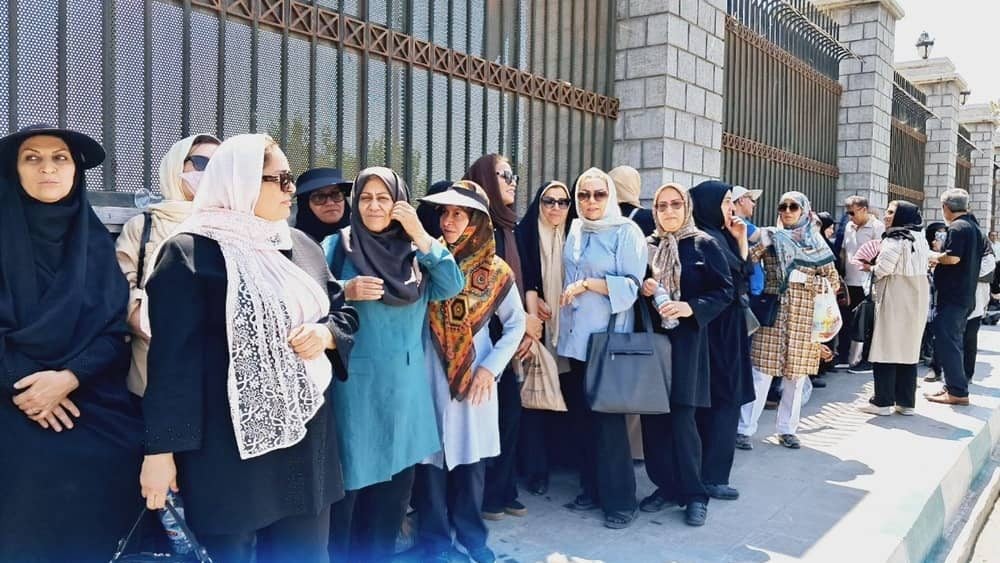Facebook
Twitter
LinkedIn
Pinterest
Reddit
Email
Print
 Tehran – August 3, 2025 – Retired Education Workers Protest Outside Parliament and Budget Organization Office
Tehran – August 3, 2025 – Retired Education Workers Protest Outside Parliament and Budget Organization Office
On August 3, 2025, a concurrent wave of protests swept across Iran, revealing the profound depth of public fury against the clerical regime. From the capital Tehran to cities like Sanandaj, Isfahan, and Nurabad Mamasani, Iranians from all walks of life took to the streets. These are not isolated incidents of discontent but clear symptoms of a collapsing state, where systemic corruption and gross incompetence have united unpaid laborers, skilled professionals, and ordinary citizens in a common and escalating struggle.
Unpaid Wages and Broken Promises
In Sanandaj, the capital of Kurdistan province, municipal workers gathered outside the city’s main administration building to protest not having received their wages for five months. These workers, who have been denied their basic right to a livelihood, also reported facing severe problems with their health insurance, underscoring a broader breakdown in essential services. Their protest was a stark indictment of a system that has abandoned its most fundamental obligations. One protester captured the sense of utter negligence, stating, “No one is held accountable.”
Simultaneously in Isfahan, retired steel and mine workers staged a protest, decrying their dire economic conditions. These pensioners are demanding the regime honor its legal commitments and implement pension equalization laws as stipulated in the country’s seventh development plan. Their gathering is part of a persistent, nationwide movement of retirees who have been pushed into poverty by the government’s chronic economic mismanagement and failure to fulfill its own laws.
August 3—Sanandaj, western Iran
Protest by municipal workers in Sanandaj, who have not received their salaries for five months and are facing very poor living conditions for themselves and their families.#IranProtestspic.twitter.com/McBXDjH8hR
— People’s Mojahedin Organization of Iran (PMOI/MEK) (@Mojahedineng) August 3, 2025
Tehran’s Engineers Sound the Alarm
In the nation’s capital, Tehran, a significant protest was held by supervising engineers in front of the City Council. They gathered to oppose a dangerous new municipal directive that allows property developers to select their own project supervisors. The engineers condemned this move as a blatant circumvention of engineering laws, designed to eliminate independent oversight and institutionalize corruption at the cost of public safety.
The protesters’ chants directly linked this policy to past tragedies caused by state-sanctioned corruption: “Municipality’s violation builds another Metropol!”—a chilling reference to the deadly 2022 building collapse in Abadan. One engineer powerfully articulated the absurdity of the policy, comparing it to “letting a plaintiff choose their own judge.” The professionals warned that this decision threatens to sideline 70% of the legal construction industry, paving the way for “custom-ordered supervisors” who serve developers’ profits, not public safety.
August 3—Isfahan, central Iran
Protest by retirees of the steel and mining sector, demanding higher pensions and access to basic services.#IranProtestspic.twitter.com/MVtVWoeuYS
— People’s Mojahedin Organization of Iran (PMOI/MEK) (@Mojahedineng) August 3, 2025
A Country in the Dark
The regime’s failure to maintain basic infrastructure ignited protests in Nurabad Mamasani in Fars province. In the early hours of Sunday morning, citizens held a spontaneous rally outside the local electricity department after suffering a four-hour power outage. The repeated, lengthy blackouts have made daily life unbearable. Protesters made it clear that their patience has run out, warning that they will no longer suffer in silence and will expand their demonstrations if the crisis is not addressed.
The protests of August 3 are more than a collection of grievances; they are a unified national indictment of a corrupt and incompetent theocracy. Whether it is a laborer in Sanandaj demanding his stolen wages, an engineer in Tehran fighting to prevent the next state-made disaster, or a family in Nurabad Mamasani demanding the simple right to electricity, the Iranian people are holding the entire regime accountable.
August 3—Tehran, Iran
Construction engineers rally in front of the municipality to protest against the removal of specialized oversight and municipal violations, which could lead to urban disasters if unaddressed.#IranProtestspic.twitter.com/1QmlkdqtLM
— People’s Mojahedin Organization of Iran (PMOI/MEK) (@Mojahedineng) August 3, 2025
The diversity of the protesters and their demands demonstrates that the crisis in Iran is systemic. From Supreme Leader Ali Khamenei down to the lowest municipal officials, the regime has proven itself incapable of governing. The ongoing protests are the true pulse of a nation determined to reclaim its future. They are a powerful signal that the regime’s foundation is more fragile than ever, and the people’s resolve to achieve freedom and democracy is unwavering.